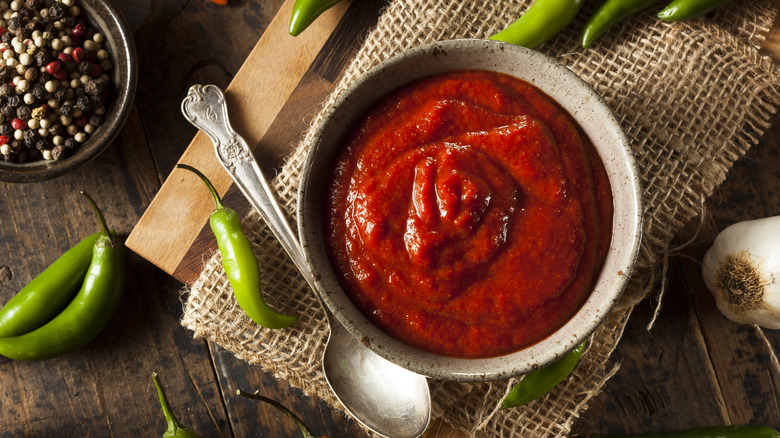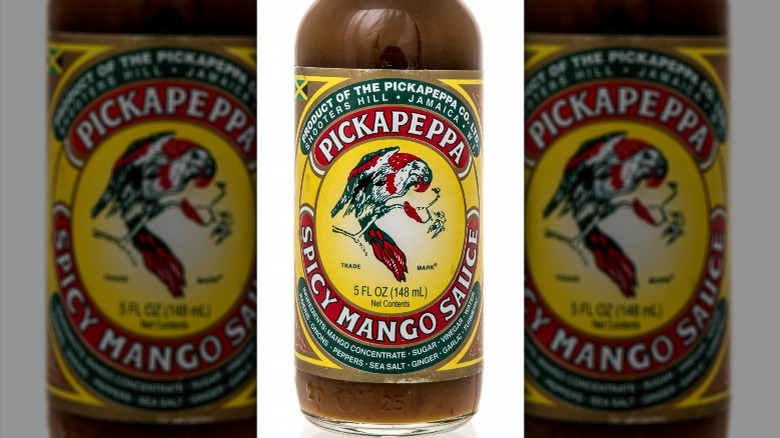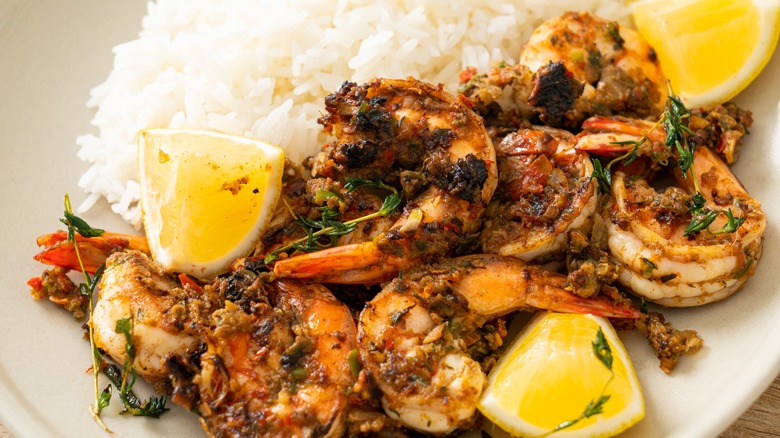Pickapeppa Is The Sweet And Tangy Jamaican Sauce You Should Know
Pickapeppa sauce has been a Jamaican staple and all-purpose condiment for over a century. Originating in 1921, the Pickapeppa Company debuted their original sweet and spicy sauce to acclaim. In its mission statement, the Pickapeppa Company draws parallels between the Pickapeppa sauce and cultural inclusivity, stating that Jamaica is a country of immigrants, and Jamaican cuisine is an amalgamation of recipes and flavors brought from distant homelands. That's why it intentionally imports sauce ingredients from the seven different countries thought to be the main origins of the current Jamaican population.
Not only is Pickapeppa sauce a celebration of diversity and cultural harmony, but it has also become representative of Jamaica abroad. The U.S. is home to one of the largest populations of Jamaican immigrants, bringing with them their beloved Pickapeppa sauce. A New Orleans-based distributor began importing Pickapeppa sauce in the '80s. Consequently, Pickapeppa sauce has developed a widespread following in the Southern states. With ingredients and flavors that feel like a culmination of Jamaica's diverse heritage, it's truly one of a kind.
What's in Pickapeppa sauce?
While some have dubbed Pickapeppa sauce "Jamaica's ketchup," it is much more complex both in composition and production. For starters, only one company produces Pickapeppa sauce, using all-natural ingredients imported from seven different countries. Its tropical profile has a tasty balance of sweet, peppery, and tangy.
On the label of the original Pickapeppa sauce, the list of ingredients contains: Tomatoes, onions, sugar, cane vinegar, mangoes, raisins, peppers, garlic, thyme, cloves, black pepper, and orange peel. The diversity of these ingredients intentionally mirrors Jamaica's cultural and culinary influences: cane sugar and mangoes are core Caribbean ingredients that originated in South and Southeast Asia, while tomatoes and chili peppers are New World crops that originated in Mexico. Another unique aspect of Pickapeppa sauce is that it's aged for one year in oak barrels. Just as oak barrel aging is championed for alcoholic spirits, it helps the sauce develop an unparalleled depth of flavor.
In addition to the original recipe, the Pickapeppa company has also come out with a line of sauces that include hot mango, ginger mango, and spicy mango. All sauces are vegan-friendly and versatile ingredients for countless dishes and cooking techniques.
How to use Pickapeppa sauce
The beauty of Pickapeppa sauce lies in its versatility; it tastes delicious as a condiment, but also adds complexity as a flavoring agent in marinades, sauces, and cooking broths. As a complex sauce that encompasses a trifecta of sweet, spicy, and tangy, it pairs well with a wide range of savory dishes, from dairy and meat to starches and vegetables. The sauce's Caribbean flare and multicultural background mirrors the rich, sweet and spicy flavor profiles of Cajun and Creole cooking, and is commonly found at restaurants and kitchen tables in Louisiana, complementing stews and gumbos. Perhaps the most famous application of Pickapeppa sauce in the South is as an hors d'oeuvre, poured over a block of cream cheese and gobbled up with crackers.
While the company acknowledges its wildly popular partnership with cream cheese, it also lists many other dishes and cooking styles to try. The sauce tastes delicious as a meat, poultry, or fish marinade or steak sauce. You could blend it with olive oil and citrus for a zesty salad dressing, or even use it to flavor mayonnaise.
Southern-style recipes also add it to red beans and rice, jambalaya, and pulled pork sandwiches. Popular Caribbean dishes that feature Pickapeppa include mango rice and barbecued shrimp. It's also a good substitute for Jamaican jerk seasoning, although Pickapeppa has a proprietary jerk marinade, too. You can even use it in place of bloody mary mix for a Caribbean twist on the famed brunch cocktail.


